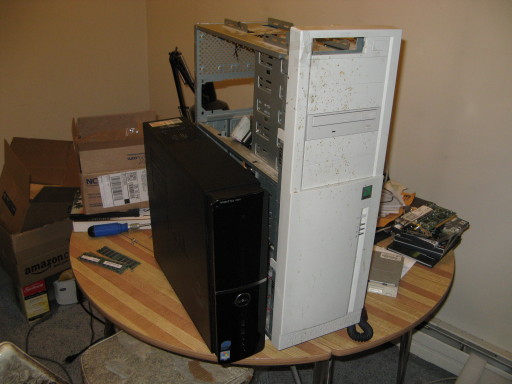I think I have all of the important stuff transferred over to the new system now, and if you’re reading this then I’ve obviously at least gotten the web services working. It’s also recording TV again, after MythTV reinstalled without a hiccup.
The only major remaining task now is transferring all of the old MythTV recordings from the old drives. That’s complicated slightly by the way I had split the filesystem over two drives, in order to use the extra space I got back on an RMA’d drive. I don’t really want to have to attach two USB enclosures to get at the data, but I think I can ‘dd’ one of them onto a local drive, attach it via loopback, and then switch the other drive into the enclosure.
So, the new setup has two internal 1TB drives, as opposed to the old system’s three drives (two 500GB, one 750GB). It’s not that much more total space, but I don’t trust the 1.5TB drives yet and this time I won’t be using RAID-1, so it’ll all be available. One drive is for the OS and /home, and the other will be solely for MythTV recordings, though I’ve set them up as logical volumes in LVM2 so I can shrink or grow them as needed.
One other new thing I’m trying this time around is having /home and swap be encrypted, roughly following this guide. Not that I have any particular national security secrets on here, but I’ve always been the paranoid type and it gives me a little peace of mind. Encryption often slows things down, but there’s a pretty beefy CPU in this box (a 3GHz E8400 that’s faster than my gaming system, even) and there isn’t too much loss. In some simple benchmarks, I get about 82MB/s off of the raw drive and 73MB/s off of the encrypted partition.
The one annoyance is that I have to manually mount /home after a reboot, since automatically doing it would defeat the purpose of encrypting it, but this system shouldn’t reboot too often anyway. Most of the essential 24/7 and MythTV services live outside of /home and don’t really need to be protected anyway.
